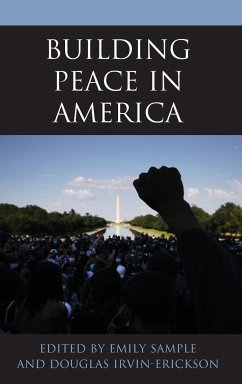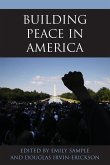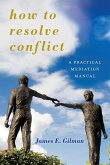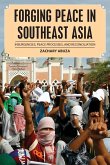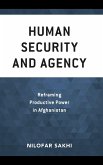Building Peace in America
Herausgeber: Irvin-Erickson, Douglas; Sample, Emily
Building Peace in America
Herausgeber: Irvin-Erickson, Douglas; Sample, Emily
- Gebundenes Buch
- Merkliste
- Auf die Merkliste
- Bewerten Bewerten
- Teilen
- Produkt teilen
- Produkterinnerung
- Produkterinnerung
Research links a wide and diverse community of scholars, practitioners, and activists towards the common goal of building peace in the United States and play a key role in helping define (and create) the field of "peacebuilding in the US."
Andere Kunden interessierten sich auch für
![Building Peace in America Building Peace in America]() Building Peace in America62,99 €
Building Peace in America62,99 €![How to Resolve Conflict How to Resolve Conflict]() James E. GilmanHow to Resolve Conflict113,99 €
James E. GilmanHow to Resolve Conflict113,99 €![How to Resolve Conflict How to Resolve Conflict]() James E. GilmanHow to Resolve Conflict45,99 €
James E. GilmanHow to Resolve Conflict45,99 €![Forging Peace in Southeast Asia Forging Peace in Southeast Asia]() Zachary AbuzaForging Peace in Southeast Asia58,99 €
Zachary AbuzaForging Peace in Southeast Asia58,99 €![Forging Peace in Southeast Asia Forging Peace in Southeast Asia]() Zachary AbuzaForging Peace in Southeast Asia125,99 €
Zachary AbuzaForging Peace in Southeast Asia125,99 €![Human Security and Agency Human Security and Agency]() Nilofar SakhiHuman Security and Agency154,99 €
Nilofar SakhiHuman Security and Agency154,99 €![Combating Criminalized Power Structures Combating Criminalized Power Structures]() Combating Criminalized Power Structures133,99 €
Combating Criminalized Power Structures133,99 €-
-
-
Research links a wide and diverse community of scholars, practitioners, and activists towards the common goal of building peace in the United States and play a key role in helping define (and create) the field of "peacebuilding in the US."
Hinweis: Dieser Artikel kann nur an eine deutsche Lieferadresse ausgeliefert werden.
Hinweis: Dieser Artikel kann nur an eine deutsche Lieferadresse ausgeliefert werden.
Produktdetails
- Produktdetails
- Peace and Security in the 21st Century
- Verlag: Rowman & Littlefield Publishers
- Seitenzahl: 272
- Erscheinungstermin: 22. Juli 2020
- Englisch
- Abmessung: 235mm x 157mm x 21mm
- Gewicht: 596g
- ISBN-13: 9781538143797
- ISBN-10: 1538143798
- Artikelnr.: 58815058
- Peace and Security in the 21st Century
- Verlag: Rowman & Littlefield Publishers
- Seitenzahl: 272
- Erscheinungstermin: 22. Juli 2020
- Englisch
- Abmessung: 235mm x 157mm x 21mm
- Gewicht: 596g
- ISBN-13: 9781538143797
- ISBN-10: 1538143798
- Artikelnr.: 58815058
Doug Irvin-Erickson is Director of the Genocide Prevention Program at George Mason University, School of Conflict Analysis and Resolution. Emily Sample is the Executive Director of the Genocide Prevention Program at George Mason University, School for Conflict Analysis and Resolution.
Introduction: Who Builds Peace? Emily Sample
Part 1: Framing our Conversation of Peacebuilding in the United States
Chapter 1: Peacebuilding Begins at Home: A Call to U.S. Peacebuilders,
Bridget Moix
Chapter 2: Social Justice as Peacebuilding in Black Churches: Where Do We
Go From Here? Beverly Janet Goins
Part 2: Doing Good (?): Dialogue, Difference, and Ethical Practice
Chapter 3: What Can They Be Thinking? Fostering Dialogue Across Divides,
Melinda Burrell
Chapter 4: Living Room Conversations: Identity Formation and Democracy,
Jessica Shryack, Linda Taylor, Beth Raps, and Joan Blades
Chapter 5: Peacebuilding Programs in the United States: First Do No Harm,
Elizabeth Hume
Part 3: Social Spaces and Social Practices of Peacebuilding
Chapter 6: Museum Education and Social Justice in Latinx Communities,
Michelle Tovar
Chapter 7: Service for Peace: Working with Students and Youth to Plant the
Future, Eddah Mutua
Chapter 8: Environmental In/Justice: Peacebuilding in the Anthropocene,
Emily Sample
Part 4: Confronting Direct and Structural Racial Violence: The Paths
Forward
Chapter 9: From Heritage Politics to Hate: Neo-Confederate Novels and White
Protectionism, Danielle Christmas
Chapter 10: Legacy of Slavery: A New Approach to Reparations, Sarah
Federman
Chapter 11: Confronting the Legacy of Lynching in Maryland: From Narrative
Change to Racial Healing, Charles Chavis, Jr.
Chapter 12: Stop Trying to Fix Policing: Lessons Learned from the Front
Lines of Black Liberation, Tony Gaskew
Part 5: In the Spirit of Self Reflection: Discussions on Gender and Nation
Chapter 13: Empowered Women Empower Women: Peacebuilding in the Age of
#MeToo, Shelly Clay-Robison, Melinda Burrell, Elizabeth Hume, Deena R.
Hurwitz, Emily Sample and Kate E. Temoney
Chapter 14: "We Don't Need No Stinkin' Peacebuilding...": The Paradox of
Order in the Shadow of Chaos, Patricia A. Maulden
Part 1: Framing our Conversation of Peacebuilding in the United States
Chapter 1: Peacebuilding Begins at Home: A Call to U.S. Peacebuilders,
Bridget Moix
Chapter 2: Social Justice as Peacebuilding in Black Churches: Where Do We
Go From Here? Beverly Janet Goins
Part 2: Doing Good (?): Dialogue, Difference, and Ethical Practice
Chapter 3: What Can They Be Thinking? Fostering Dialogue Across Divides,
Melinda Burrell
Chapter 4: Living Room Conversations: Identity Formation and Democracy,
Jessica Shryack, Linda Taylor, Beth Raps, and Joan Blades
Chapter 5: Peacebuilding Programs in the United States: First Do No Harm,
Elizabeth Hume
Part 3: Social Spaces and Social Practices of Peacebuilding
Chapter 6: Museum Education and Social Justice in Latinx Communities,
Michelle Tovar
Chapter 7: Service for Peace: Working with Students and Youth to Plant the
Future, Eddah Mutua
Chapter 8: Environmental In/Justice: Peacebuilding in the Anthropocene,
Emily Sample
Part 4: Confronting Direct and Structural Racial Violence: The Paths
Forward
Chapter 9: From Heritage Politics to Hate: Neo-Confederate Novels and White
Protectionism, Danielle Christmas
Chapter 10: Legacy of Slavery: A New Approach to Reparations, Sarah
Federman
Chapter 11: Confronting the Legacy of Lynching in Maryland: From Narrative
Change to Racial Healing, Charles Chavis, Jr.
Chapter 12: Stop Trying to Fix Policing: Lessons Learned from the Front
Lines of Black Liberation, Tony Gaskew
Part 5: In the Spirit of Self Reflection: Discussions on Gender and Nation
Chapter 13: Empowered Women Empower Women: Peacebuilding in the Age of
#MeToo, Shelly Clay-Robison, Melinda Burrell, Elizabeth Hume, Deena R.
Hurwitz, Emily Sample and Kate E. Temoney
Chapter 14: "We Don't Need No Stinkin' Peacebuilding...": The Paradox of
Order in the Shadow of Chaos, Patricia A. Maulden
Introduction: Who Builds Peace? Emily Sample
Part 1: Framing our Conversation of Peacebuilding in the United States
Chapter 1: Peacebuilding Begins at Home: A Call to U.S. Peacebuilders,
Bridget Moix
Chapter 2: Social Justice as Peacebuilding in Black Churches: Where Do We
Go From Here? Beverly Janet Goins
Part 2: Doing Good (?): Dialogue, Difference, and Ethical Practice
Chapter 3: What Can They Be Thinking? Fostering Dialogue Across Divides,
Melinda Burrell
Chapter 4: Living Room Conversations: Identity Formation and Democracy,
Jessica Shryack, Linda Taylor, Beth Raps, and Joan Blades
Chapter 5: Peacebuilding Programs in the United States: First Do No Harm,
Elizabeth Hume
Part 3: Social Spaces and Social Practices of Peacebuilding
Chapter 6: Museum Education and Social Justice in Latinx Communities,
Michelle Tovar
Chapter 7: Service for Peace: Working with Students and Youth to Plant the
Future, Eddah Mutua
Chapter 8: Environmental In/Justice: Peacebuilding in the Anthropocene,
Emily Sample
Part 4: Confronting Direct and Structural Racial Violence: The Paths
Forward
Chapter 9: From Heritage Politics to Hate: Neo-Confederate Novels and White
Protectionism, Danielle Christmas
Chapter 10: Legacy of Slavery: A New Approach to Reparations, Sarah
Federman
Chapter 11: Confronting the Legacy of Lynching in Maryland: From Narrative
Change to Racial Healing, Charles Chavis, Jr.
Chapter 12: Stop Trying to Fix Policing: Lessons Learned from the Front
Lines of Black Liberation, Tony Gaskew
Part 5: In the Spirit of Self Reflection: Discussions on Gender and Nation
Chapter 13: Empowered Women Empower Women: Peacebuilding in the Age of
#MeToo, Shelly Clay-Robison, Melinda Burrell, Elizabeth Hume, Deena R.
Hurwitz, Emily Sample and Kate E. Temoney
Chapter 14: "We Don't Need No Stinkin' Peacebuilding...": The Paradox of
Order in the Shadow of Chaos, Patricia A. Maulden
Part 1: Framing our Conversation of Peacebuilding in the United States
Chapter 1: Peacebuilding Begins at Home: A Call to U.S. Peacebuilders,
Bridget Moix
Chapter 2: Social Justice as Peacebuilding in Black Churches: Where Do We
Go From Here? Beverly Janet Goins
Part 2: Doing Good (?): Dialogue, Difference, and Ethical Practice
Chapter 3: What Can They Be Thinking? Fostering Dialogue Across Divides,
Melinda Burrell
Chapter 4: Living Room Conversations: Identity Formation and Democracy,
Jessica Shryack, Linda Taylor, Beth Raps, and Joan Blades
Chapter 5: Peacebuilding Programs in the United States: First Do No Harm,
Elizabeth Hume
Part 3: Social Spaces and Social Practices of Peacebuilding
Chapter 6: Museum Education and Social Justice in Latinx Communities,
Michelle Tovar
Chapter 7: Service for Peace: Working with Students and Youth to Plant the
Future, Eddah Mutua
Chapter 8: Environmental In/Justice: Peacebuilding in the Anthropocene,
Emily Sample
Part 4: Confronting Direct and Structural Racial Violence: The Paths
Forward
Chapter 9: From Heritage Politics to Hate: Neo-Confederate Novels and White
Protectionism, Danielle Christmas
Chapter 10: Legacy of Slavery: A New Approach to Reparations, Sarah
Federman
Chapter 11: Confronting the Legacy of Lynching in Maryland: From Narrative
Change to Racial Healing, Charles Chavis, Jr.
Chapter 12: Stop Trying to Fix Policing: Lessons Learned from the Front
Lines of Black Liberation, Tony Gaskew
Part 5: In the Spirit of Self Reflection: Discussions on Gender and Nation
Chapter 13: Empowered Women Empower Women: Peacebuilding in the Age of
#MeToo, Shelly Clay-Robison, Melinda Burrell, Elizabeth Hume, Deena R.
Hurwitz, Emily Sample and Kate E. Temoney
Chapter 14: "We Don't Need No Stinkin' Peacebuilding...": The Paradox of
Order in the Shadow of Chaos, Patricia A. Maulden
